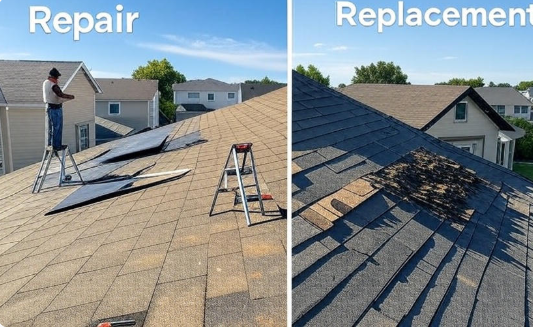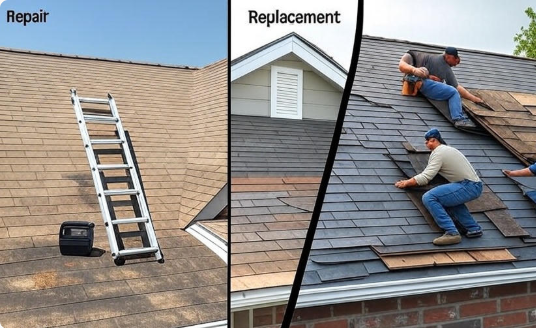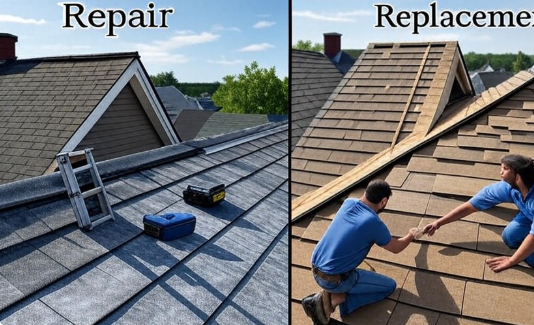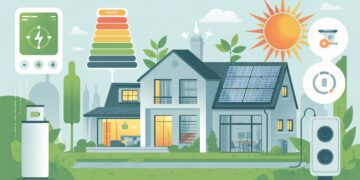When your roof begins to show signs of wear and tear, you’re faced with an important decision: should you repair it or replace it altogether? This isn’t just a matter of cost. It’s about the safety of your home, its energy efficiency, and its long-term value. Making the right choice between roof repair and replacement can protect your investment and give you peace of mind for years to come.
This guide provides a comprehensive analysis of both options so you can make an informed decision. We will explore when each is appropriate, what factors to consider, and the costs involved.
Why Your Roof Matters
Your roof serves as your home’s first line of defense against the elements. It protects the interior from water damage, supports energy efficiency by insulating the home, and contributes to curb appeal and property value. When roofing problems arise, it’s critical to address them quickly to avoid more serious issues.
Ignoring roof problems can result in:
- Water infiltration and interior damage
- Mold growth
- Higher energy bills due to poor insulation
- Structural deterioration
Understanding whether a simple repair will suffice or a full replacement is needed is key to avoiding future headaches and expenses.
What Is Roof Repair?
Roof repair involves fixing specific, isolated issues without replacing the entire roofing system. This can include:
- Replacing missing or damaged shingles
- Fixing leaks
- Repairing flashing
- Patching underlayment
- Sealing gaps around chimneys or vents
Repairs are typically cost-effective and suitable when the roof is still within its useful life, and the damage is localized.
What Is Roof Replacement?
Roof replacement means removing the existing roofing materials and installing a new system. This may include tearing off shingles, underlayment, flashing, and sometimes even the decking. The process ensures any hidden damage is addressed, and it allows for new, modern materials to be installed that may offer better performance and efficiency.
Roof replacement is recommended when:
- The roof is near the end of its expected lifespan
- There’s widespread damage
- Repairs have become frequent and costly
- Energy efficiency needs to be improved
Factors That Influence Your Decision
1. Age of the Roof
The age of your roof is one of the most important factors in deciding between repair and replacement. Common roofing materials have the following lifespans:
- Asphalt Shingles: 15–30 years
- Wood Shakes: 20–40 years
- Metal Roofing: 40–70 years
- Clay/Concrete Tile: 50+ years
- Slate: 75–100+ years
If your roof is approaching the end of its expected life, replacing it may be more cost-effective than repeatedly repairing aging materials.
2. Extent of Damage
Localized damage can often be repaired. However, if the damage covers more than 25-30% of the roof, or there are signs of structural issues like sagging, a full replacement might be the best option.
3. Frequency of Repairs
If you’re calling a roofer more than once every couple of years, your roof is telling you it’s time for a replacement. Recurrent issues often indicate deeper, systemic problems.
4. Roof Leaks
Leaks are often the first visible sign of roofing trouble. A single leak may require only a patch. However, if you’re experiencing multiple leaks, or water stains are appearing on ceilings and walls in various parts of the house, replacement may be the more reliable solution.
5. Storm or Hail Damage
Severe weather events can damage large sections of roofing. While some damage can be repaired, it often takes a professional inspection to determine whether the roof’s integrity has been compromised.
6. Roofing Material
The type of material impacts both the repair process and the potential for replacement. For instance:
- Asphalt shingles can often be easily repaired.
- Tile and slate roofs are more complex and expensive to repair.
- Metal roofing is durable but may require specialized expertise to fix.
7. Building Codes and Regulations
Some local building codes allow for only one layer of roofing material. If your roof has already been re-roofed once, local code may require a full tear-off and replacement.
8. Energy Efficiency
Old roofs may lack proper insulation or ventilation, leading to high energy costs. Replacing a roof allows you to install energy-efficient materials and better insulation.
9. Plans for the Property
If you plan to stay in your home long-term, a replacement may be a better investment. If you’re selling soon, a new roof can be a significant selling point. Alternatively, a quick repair may suffice if you’re only trying to address visible issues.
Roof Repair vs Roof Replacement – Which to Choose?
When deciding between roof repair and roof replacement, it’s important to assess your specific situation. Use the table below as a quick guide:
Factor |
Roof Repair |
Roof Replacement |
|---|---|---|
Cost |
Lower initial expense |
Higher upfront cost |
Time |
Usually 1 day |
Several days to a week |
Lifespan |
Short-term solution |
Long-term investment |
Warranty |
Limited |
Comprehensive (20-50 years) |
Home Value Impact |
Minor |
Significant increase |
Energy Efficiency |
No change |
Often improved |
Damage Coverage |
Limited/localized |
Full system upgrade |
When weighing roof repair vs roof replacement – which to choose, it helps to look not only at immediate costs but also at long-term benefits, warranties, and peace of mind.
Pros and Cons
Pros of Roof Repair
- Less expensive upfront
- Fast turnaround
- Maintains original materials and appearance
- Ideal for newer roofs
Cons of Roof Repair
- Doesn’t address underlying issues
- May lead to repeated expenses
- Warranty might be limited or voided
Pros of Roof Replacement
- Full system reset with new materials
- Long warranty
- Energy savings potential
- Boosts resale value
Cons of Roof Replacement
- High initial cost
- Longer installation time
- May require temporary relocation (in extreme cases)
Cost Comparison
Average Roof Repair Costs
- Minor Leak: $150 – $400
- Flashing Fix: $200 – $500
- Shingle Patch: $300 – $1,000
- Underlayment Repair: $400 – $1,200
Average Roof Replacement Costs
- Asphalt Shingle Roof: $5,000 – $12,000
- Metal Roof: $10,000 – $25,000
- Tile Roof: $15,000 – $30,000
- Slate Roof: $20,000 – $50,000
Prices vary by region, roof size, material, labor, and access difficulty.
Signs You May Need a Roof Replacement
- Your roof is 20+ years old
- Multiple or recurring leaks
- Curling or missing shingles
- Granules in gutters
- Daylight visible in attic
- Sagging roof deck
- Rising energy bills
Signs a Roof Repair May Be Enough
- Roof is less than 10 years old
- Damage is minor and isolated
- No underlying structural issues
- You’re on a limited budget and need a quick fix
Maintenance Tips to Extend Roof Life
- Inspect the roof twice a year
- Clean gutters regularly
- Remove overhanging branches
- Address minor issues immediately
- Ensure proper attic ventilation
FAQs
Can I re-roof over my existing roof?
Yes, but only if local codes allow it and the existing roof is in decent condition. Usually, only one layer is allowed.
How long does a roof replacement take?
Most standard home roof replacements take 3 to 5 days, depending on size, material, and weather conditions.
Is roof replacement tax-deductible?
Typically, no. However, if it’s part of a rental property or business, some deductions may apply. Energy-efficient upgrades may qualify for tax credits.
Will insurance cover my roof repair or replacement?
Insurance often covers damage caused by unexpected events (e.g., storms or fires). Wear and tear is generally excluded.
How can I choose a reliable roofing contractor?
- Verify licenses and insurance
- Check reviews and ratings
- Get multiple written estimates
- Ask about warranties and certifications
Final Thoughts: Roof Repair vs Roof Replacement – Which to Choose?
Deciding whether to repair or replace your roof depends on several key factors: the age of your roof, the extent of damage, your budget, and your long-term plans. Roof repair may be suitable for minor, isolated issues, especially if your roof is relatively young. In contrast, replacement is often the better choice for older roofs or when dealing with widespread or recurring problems.
Always consult with a licensed roofing professional to assess your situation accurately. They can provide a detailed inspection and recommend the most cost-effective, long-term solution for your home.
Whether you opt for a small repair or a full replacement, addressing roofing issues proactively is the best way to protect your home, your family, and your investment.












